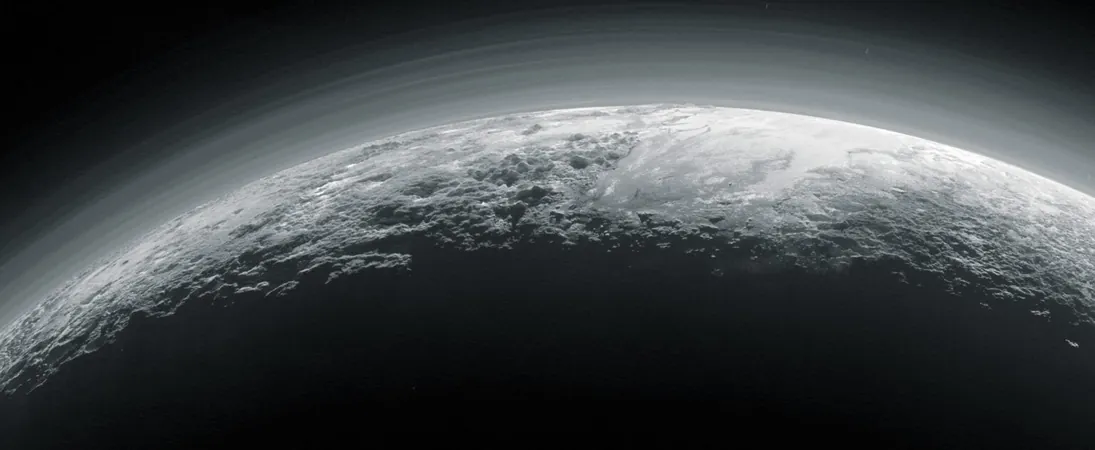
Pluto's Mysterious Haze: A New Era of Discoveries from the James Webb Space Telescope
2025-06-04
Author: Wei Ling
A Groundbreaking Discovery on Pluto's Atmosphere
When NASA's New Horizons spacecraft whisked past Pluto and its moon Charon in 2015, it unveiled astonishing details about these distant worlds, including Pluto’s active atmosphere that shook our understanding of the outer Solar System. Fast forward to the latest revelations from the James Webb Space Telescope (JWST), which have revealed that Pluto's atmosphere is unlike any other in the entire Solar System, featuring intriguing haze particles that expand and contract with temperature changes.
The Curious Case of Pluto's Haze
Composed of a unique mix of nitrogen, methane, and carbon monoxide, Pluto's atmosphere operates like a living organism, with haze particles crucially influencing its thermal balance. This phenomenon, which hasn’t been observed on other celestial bodies, was first hinted at by astronomer Xi Zhang from the University of California, Santa Cruz, back in 2017. 'It was a crazy idea,' Zhang admitted, yet his hypothesis regarding the cooling effect of haze has been spectacularly validated by recent JWST observations.
Exciting Confirmation of Revolutionary Theories
A team led by Tanguy Bertrand from the Observatoire de Paris harnessed the JWST’s capabilities to delve deeper into these hazy secrets. Their confidence surged as the telescope confirmed the hypothesis that haze cooling should emit pronounced mid-infrared radiation. 'We were really proud that our prediction was confirmed so quickly; it’s rare in planetary science to see such results in just a few years!' Zhang exclaimed, his enthusiasm palpable.
Pluto and Charon: Atmospheric Contrasts
Unlike Pluto, Charon remains largely devoid of atmosphere, experiencing only slight seasonal outgassing. The hazy experiments over Pluto's surface resemble those on Saturn’s moon Titan, but long-term observations reveal the complex interactions that New Horizons simply couldn't capture. The JWST's precise observations in 2022 and 2023 focused on the mid-infrared range of Pluto’s atmosphere, revealing the ebb and flow of its mystical hues.
Revealing the Secrets of Thermal Radiation
Recent measurements have uncovered fascinating temperature variations on both Pluto and Charon as they rotate, allowing researchers to refine models of their thermal behaviors. These findings hint at Pluto’s unique ability to migrate icy deposits across its surface, leading to intriguing interactions between Pluto and Charon that are unmatched in the Solar System.
A Unique Atmosphere with Earthly Implications
What sets Pluto apart is how its haze particles predominantly govern its energy balance, contrary to other celestial atmospheres where gas molecules take precedence. Zhang emphasized the significance of this discovery, suggesting that studying Pluto could illuminate the environmental conditions that fostered early Earth’s habitability.
A Glimpse into the Future of Atmospheric Research
The JWST studies mark just the beginning of our journey into Pluto’s atmospheric complexity and its affect on Charon. As Zhang aptly put it, 'Pluto sits uniquely within the roundtable of planetary atmospheres, providing us with invaluable insights into extreme haze behavior.' This research extends beyond Pluto, challenging us to reassess the atmospheric dynamics of other hazy worlds like Neptune’s moon Triton and Titan.

 Brasil (PT)
Brasil (PT)
 Canada (EN)
Canada (EN)
 Chile (ES)
Chile (ES)
 Česko (CS)
Česko (CS)
 대한민국 (KO)
대한민국 (KO)
 España (ES)
España (ES)
 France (FR)
France (FR)
 Hong Kong (EN)
Hong Kong (EN)
 Italia (IT)
Italia (IT)
 日本 (JA)
日本 (JA)
 Magyarország (HU)
Magyarország (HU)
 Norge (NO)
Norge (NO)
 Polska (PL)
Polska (PL)
 Schweiz (DE)
Schweiz (DE)
 Singapore (EN)
Singapore (EN)
 Sverige (SV)
Sverige (SV)
 Suomi (FI)
Suomi (FI)
 Türkiye (TR)
Türkiye (TR)
 الإمارات العربية المتحدة (AR)
الإمارات العربية المتحدة (AR)